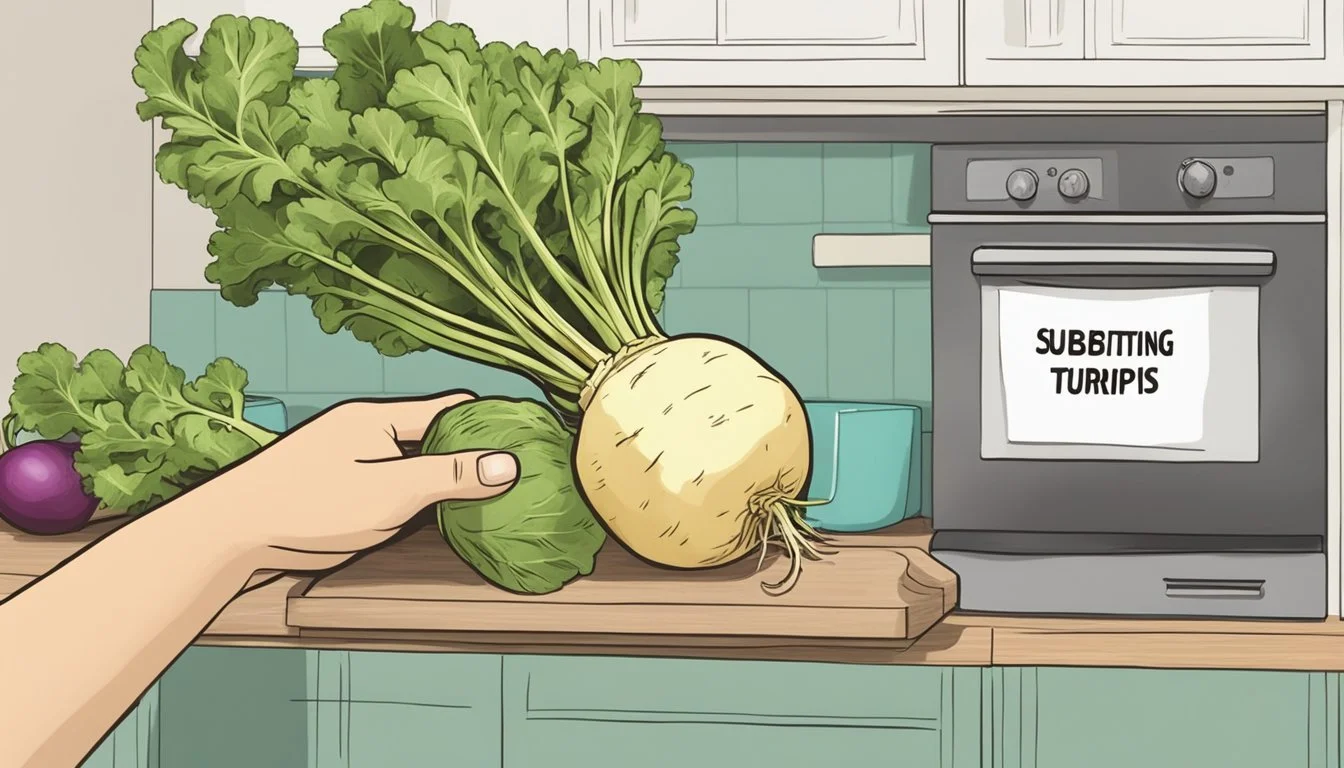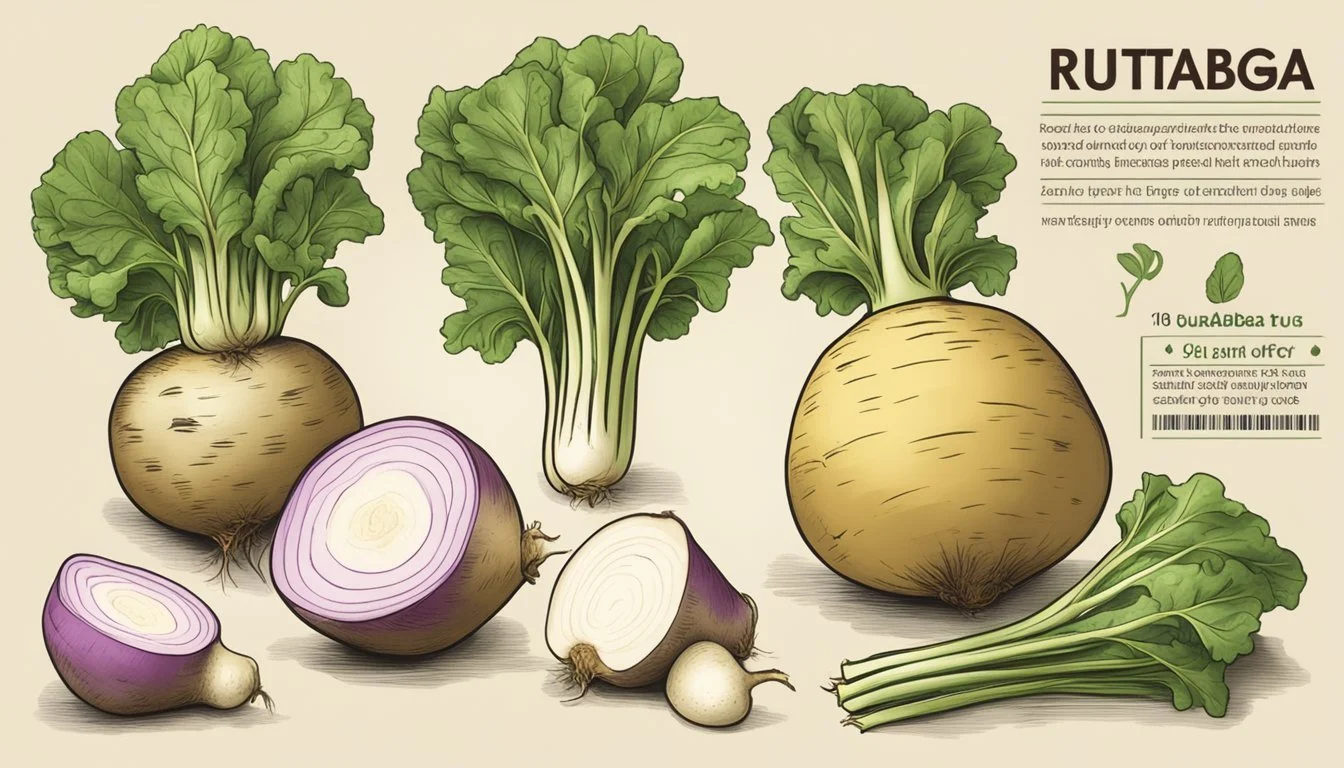How to Substitute Rutabaga for Turnips
A Simple Guide for Recipe Swaps
When cooking, finding a suitable replacement for an ingredient can save a recipe. Rutabagas are an excellent choice for substituting turnips due to their textural similarities and complementary flavors. Although they are a bit sweeter and less starchy, rutabagas can be prepared in much the same way as turnips. Both root vegetables bring a uniquely bittersweet taste to dishes and can be used interchangeably in most recipes.
Rutabagas, larger and with a yellowish-brown exterior, differ from the typically smaller, white, and purple turnips. This distinction in color is one of the few visual cues that set them apart, but when it comes to cooking, they can often be used to achieve similar results. Whether one is roasting, mashing, or incorporating them into stews, the rutabaga makes for a robust alternative that maintains the integrity of the dish.
Providing essential nutrients, rutabagas are not just a stand-in for turnips but also a choice that may enrich a meal with additional culinary qualities. Their slightly milder flavor profile can be advantageous in recipes where a more subdued taste is desired. Cooks can utilize rutabagas with confidence, knowing that the end result will be close to the original intention, even in the absence of turnips.
Understanding Root Vegetables
In seeking to substitute one root vegetable for another, it's critical to recognize their distinct characteristics and nutritional values. This knowledge ensures a successful replacement in recipes, maintaining both flavor profiles and health benefits.
Characteristics of Rutabaga
Rutabagas are a hardy root vegetable known for their dense and slightly sweet flesh. They are typically larger than turnips and possess a yellow to tan outer skin. With a round shape, the interior of a rutabaga ranges from yellow to orange. Its texture is firm, becoming tender and milder in taste upon cooking. The rutabaga can withstand longer cooking times compared to turnips and may need to be cut into smaller pieces when substituted to ensure even cooking.
Nutritional Profile of Turnips and Rutabagas
Both turnips and rutabagas are low-calorie vegetables that provide an array of nutrients. They are rich sources of dietary fiber, vitamin C, and potassium, contributing to overall health and well-being. Here is a comparison of their nutritional content per 3.5 ounces (100 grams):
Turnips:
Fiber: 2 grams
Vitamin C: 21 mg
Potassium: 191 mg
Protein: 0.9 grams
Calcium: 30 mg
Iron: 0.3 mg
Rutabagas:
Fiber: 2.3 grams
Vitamin C: 25 mg
Potassium: 350 mg
Protein: 1.1 grams
Calcium: 43 mg
Iron: 0.44 mg
The higher amounts of vitamin C and potassium in rutabagas make them a slightly more nutrient-dense option compared to turnips. Their robust nutrient profile supports immune function and bone health while providing necessary components for maintaining energy levels and muscle function.
Preparing Root Vegetables
When substituting rutabagas for turnips, proper preparation is crucial. This includes mastering skinning and cutting techniques and understanding the best methods to cook these root vegetables to take full advantage of their flavors and textures.
Skinning and Cutting Techniques
Rutabagas and turnips have thick skin that is best removed using a sharp knife or a sturdy peeler. Skinning should be done with care to preserve as much of the vegetable flesh as possible. Once peeled, cutting the vegetables into uniform sizes ensures even cooking. Chunks or cubes are ideal for roasting or boiling, while thin slices may be preferable for grilling.
Peeling: Use a peeler or a knife.
Slicing: Aim for uniform thickness.
Cubing: Best for even cooking in various recipes.
Best Methods for Cooking Rutabagas and Turnips
Once prepped, both vegetables are versatile and can be cooked using similar methods. Roasting rutabagas and turnips brings out their natural sweetness and imparts a desirable caramelized texture. Typically, they are roasted at a medium to high temperature until fork-tender.
For a mashed or puree consistency, boiling is suitable. Boil in water until they can be easily pierced with a fork, then mash to achieve a smooth and creamy texture. Adding butter, cream, or seasonings can enhance their mild flavors.
Roasted:
Temperature: 375-425°F (190-220°C)
Time: 25-35 minutes until fork-tender
Boiled/Mashed:
Water: Enough to cover cubes or slices
Time: 20-30 minutes or until soft
Add-ins: Butter, cream, salt, and pepper for flavor
Substituting Rutabagas for Turnips
In the realm of root vegetables, rutabagas provide an excellent alternative to turnips, offering a similar taste and texture profile that suits most recipes calling for turnips.
Flavor and Texture Comparisons
Rutabagas and turnips are both members of the Brassica genus, which explains their comparable characteristics. Rutabagas generally have a mild flavor compared to the slightly peppery taste of turnips. They are typically sweeter and less spicy, making them versatile in dishes that require a subtle sweetness.
In terms of texture, rutabagas are denser and less crunchy than turnips, but they can be used in the same context, especially when cooked. The root vegetables are often interchangeable when mashing is part of a recipe, as the textural difference becomes negligible once prepared in this fashion.
Adjusting Recipes for Substitution
When substituting rutabagas for turnips, one must consider the slight sweetness and milder flavor of rutabagas. In recipes where turnips provide a peppery kick, a cook might add a pinch of ground mustard or horseradish to emulate that sharpness.
Here’s a brief guideline on how to adjust recipes:
Raw Dishes: Slice or cube rutabagas thinner than turnips to compensate for their denser texture.
Cooked Dishes: Increase cooking time slightly due to the rutabaga's density.
Mashed: Use a 1:1 ratio when substituting, but taste and adjust seasonings as necessary since rutabagas are milder and sweeter.
One should note that the increased sweetness of rutabagas can enhance certain dishes, offering a delightful twist on the expected flavor profile. Overall, they offer a similar taste and texture that allows them to seamlessly integrate into recipes calling for turnips.
Recipe-Specific Substitution Guidelines
When substituting rutabaga for turnips, it’s essential to keep the particular characteristics of the dish in mind. Rutabagas can be interchanged successfully with turnips in many recipes, given their similar texture and taste profiles, but slight adjustments might be necessary to achieve the desired outcome.
Using Rutabagas in Stews and Casseroles
In stews or casseroles where turnips are called for, one can replace them with rutabagas in a 1:1 ratio. However, chefs should note that rutabagas have a slightly sweeter taste and are less peppery. They tend to hold their shape better due to a denser texture, making them ideal for slow-cooked dishes where prolonged cooking times are involved.
Preparation Tip: Peel and dice the rutabaga into uniform pieces for even cooking.
Cooking Adjustment: Taste-test stew or casserole periodically, as the seasoning may need to be adjusted to balance the sweetness of the rutabaga.
Creating Salads with Rutabagas
When crafting a salad that typically features turnips, one can creatively adapt by using raw rutabaga. Given that rutabagas are less spicy and a bit sweeter than turnips, they can provide a more mellow flavor to the salad, which might be desirable in some recipes.
Texture Note: Rutabagas should be finely shredded or julienned to match the texture typically provided by raw turnip in salads.
Seasoning Suggestion: To counterbalance the sweetness, consider dressing the salad with vinaigrettes that have a slightly acidic or sharp profile.
Additional Tips and Tricks
When substituting rutabaga for turnips, maintaining freshness and enhancing the flavors are crucial steps towards creating a successful dish.
Storing Rutabagas and Turnips for Freshness
Rutabagas and turnips should be stored properly to retain their quality and taste. For maximum freshness, they should be kept in a cool, dark place, ideally in the refrigerator. Wrapping them loosely in a plastic bag before refrigerating can help retain moisture. They can stay fresh for several weeks when stored between 32°F and 35°F.
Enhancing Flavor with Seasonings
The right seasonings can elevate the natural taste of rutabagas when used as a turnip substitute. One can employ simple seasonings like salt to bring out the sweetness, or add a pat of butter for richness and a creamy texture. For added complexity, a dash of sugars or honey can balance the earthy notes of rutabagas, especially when roasted.
Health and Dietary Considerations
When considering the substitution of rutabaga for turnips, one must take into account various health and dietary considerations.
Nutritional Content: Both vegetables are low in calories, making them excellent choices for weight management. They also provide essential nutrients that contribute to overall health.
Fiber: Rutabagas are an excellent source of dietary fiber, which is important for digestive health. A higher fiber content helps support a healthy gut and may aid in the prevention of constipation.
Nutrient Rutabaga Turnip Calories Low Low Fiber Higher Lower Sodium Low Low
Sodium: For individuals monitoring their sodium intake, both rutabaga and turnips contain low levels of sodium. This makes them safe for inclusion in a heart-healthy diet.
Benefits: Including rutabagas or turnips in one's diet can offer benefits such as contributing to one's daily intake of vitamins and minerals. They can both be part of a balanced diet, supporting overall health and well-being.
It's important for individuals with specific dietary restrictions or health conditions to consult with a healthcare provider before making changes to their diet. The substitution should align with the individual's nutritional needs and health objectives.






